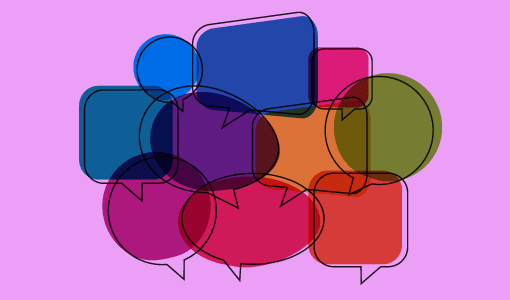How To Listen Actively In Customer Service
Dave Salisbury discusses how contact centres tin build customer listening skills and improve customer service every bit a result.
Where Customer Listening Goes Wrong
Consider the last time that you lot watched a press briefing on the news. A room total of people who would merits they are professional listeners, who then report what is being said.
Yet how many times exercise you see questions asked with an agenda, personal opinions warping what was said into what they desired to hear? Every. Unmarried. Time. (*coughing* Play tricks and CNN).
Advisors often presume the customer's trouble from the off and so direct the customer in the way that they desire.
A similar kind of thing goes on in the contact centre too. Advisors often presume the client'due south problem from the off and then straight the customer in the way that they desire. They rush to conclusions, without taking the time to listen properly and fully empathise the problem.
This process shines a light on the bug with agile listening and how active listening can exist faked – which is understandable in an environs where advisors have to be fully switched on, phone call later call.
Where Else Does Client Listening Go Incorrect?
Of class, advisors faking active listening isn't the only place where customer listening can go wrong. The team will often have the best of intentions, yet they face up many of the post-obit obstacles:
one. Multitasking – If your partner is watching a game of football equally you communicate with them, will their listening skills be sharp? No. The same logic applies to contact centres.
When taking a call, an advisor may have to bargain with navigating multiple systems or colleagues asking them if they'd like a drinkable or something else of that nature, which distracts them from listening.
2. Noisy Backgrounds – Whether your headsets are of low quality, the contact middle is rather crowded or y'all piece of work with remote advisors who alive in noisy buildings, loud backgrounds tin can be a real distraction.
And so don't think almost removing background racket solely from the point of view of the customer, consider how a loud environment will bear on an advisor's listening skills too.
Don't think about removing groundwork noise solely from the bespeak of view of the customer, consider how a loud environment will impact an advisor's listening skills too.
3. Strict Metrics – Many contact centres still target advisors on Average Handling Time (AHT) and if advisors are being punished on talk time, then they volition start skipping through things and practiced listening practices will get out the window.
This is only 1 example of why we have got to be careful that the Key Performance Indicators (KPIs) that we are using are driving the correct behaviours.
iv. Poor Resourcing – If we have fewer people than we need in the contact centre, for whatever reason, advisors are often made to feel nether pressure.
When this happens and nosotros take to deal with unexpected spikes in call volume, that can again cause our listening skills to endure.
Removing some of these barriers can be a good start to improving customer listening skills, before we move on to the adjacent stage…
Replace Active Listening With Reflective Listening
While active listening tin can be faked, cogitating listening cannot. Just consider the differing definitions of active and reflective listening that are presented below, in what we tin can call the four levels of customer listening:
- Inactive listening – This is where you are hearing words or seeing written communication, only it'southward having zero impact mentally. This is generally because your internal voices drown out the possibility for advice.
- Selective listening – Common in contact centres, selective listening is when you only listen to what confirms your own voices, opinions and biases. While others are speaking, you are already forming your response.
- Active listening – This is where you testify the other person y'all are paying attention and appoint with meaning in a reply.
- Reflective listening – Every bit best practice, cogitating listening involves paying attending to intent and content and reducing emotion. It is bidirectional equally both parties are engaged in achieving mutual agreement.
From these definitions, we can run into that cogitating listening involves reflecting dorsum parts of what the customer has said to demonstrate a mutual understanding.
Non only is this much harder to fake, just if we can demonstrate that we sympathise the customer's trouble, any subsequent evidence of empathy becomes much more accurate. It besides makes rapport building easier.
These are big pluses, just good customer listening requires more than reflecting dorsum what the customer has said. We must likewise adapt well to the flow of the chat thereafter.
To Heed Well, We Must Also Accommodate Our Communication Manner
Good communicators will utilize cogitating listening and adapt their message to the audience.
To be able to adapt their communication mode, a expert listener in the contact centre volition:
- Be well trained past an enthusiastic team leader, who office-plays scenarios and teaches advisors to mentally prepare for each call, so they don't outset making basic assumptions.
- Probe the customer, and alter their phrasing based on whether the customer is looking to find a solution or move away from a problem.
- Look to clarify what is being said, through reflective listening, in order to achieve a mutual understanding.
Nevertheless, too often those labelled as "good communicators" cannot listen reflectively as they fall into dangerous routines of assuming the customer's problem.
Ideally, though, our continuous coaching and civilization will aid to build a client service focus which cultivates an attitude and desire to assistance customers.
Detect out how to build a customer service focus in our article: How to Reach Fantabulous Customer Service Through Coaching
How Else Can Nosotros Improve Customer Listening?
The following are some launch points for improving client listening and developing the right attitudes and desires in the contact eye:
1. Empathise your want. Know and understand that what you lot desire from an interaction determines its success.
2. Practice mental grooming, based upon previous situations, to make dissimilar choices. Listening is a voyage of discovery to reach a common understanding, but mental preparation is key to safely reaching the destination.
Set up and do until what currently feels conflicting becomes familiar. Doing so in forepart of a mirror is always all-time practice.
3. Reduce emotion. The principles of empathy and sympathy can impairment an counselor'southward power to listen, if taught in the incorrect manner.
If the counselor feels equally though they must show empathy at some point in the call, their internal voice will focus on finding the opportunity to demonstrate empathy.

The volume of internal voices can silence the ability to listen reflectively
The volume of internal voices can silence the ability to listen reflectively, fuelling the need to fake agile listening for employment's sake.
4. Listen as you would have others listen to you. This is an adaptation of the "Golden Dominion" and remains applicable every bit a personal choice. How you choose to listen volition make up one's mind your destiny.
v. Body language is a non-exact communication aqueduct that can exist heard equally well as seen.
How are you communicating not-verbally and how is that interfering with your written and verbal communication attempts? It's important that advisors ask these questions of themselves.
Call back, listening remains the number-one tool y'all control, and its principles apply to written channels, not just the phone.
More than Nifty Advice for Improving Customer Service Listening Skills
In addition to all of Dave's bang-up communication on improving customer listening skills, we also take a great video to share with yous from Carolyn Edgeless, a Business Evolution Director at FWD Training & Consultancy.
The video shows Carolyn taking united states through here favourite five tips for improving listening skills.

Carolyn Edgeless
For those of you who lack the time to listen to the reasoning behind every tip that is presented in the video, here is a quick rundown of Carolyn's 5 tips.
- Beware of solution-focused thinking
- Speed is the enemy of expert listening
- Uncover your secret narcissists
- Identify the chatter that you need to silence
- Exercise makes perfect
To hear more than from Carolyn on how to improve customer listening, read our article: Top Tips to Improve Listening Skills on the Phone
Terminal Thoughts
"Most people do non listen with the intent to understand; they listen with the intent to reply." – Stephen Covey, Author of The Seven Habits of Highly Effective People.
Most people do not mind with the intent to understand; they listen with the intent to reply.
The trouble that Covey describes here is one of the biggest that we face inside the client service industry today.
Why? Because listening is hard. Yet it's also a choice.

Dave Salisbury
Every bit many people take pointed out, we have two ears and 1 mouth, and so we can heed twice as often every bit we speak.
And then encompass listening. Choose to mind reflectively, choose to attain a common understanding and watch your destiny change.
Good luck!
Cheers to Dave Salisbury, an Operations and Customer Relations Specialist, for putting together this article.
For more from Dave Salisbury, read some of his other articles by following the links beneath:
- Key Performance Indicators (KPIs) Are Dissentious Employee Appointment
- What "Going the Extra Mile" REALLY Means in Customer Service
- What Is the Purpose and Mission of Your Contact Center?
How To Listen Actively In Customer Service,
Source: https://www.callcentrehelper.com/improve-customer-service-listening-skills-161008.htm
Posted by: chaconundeng.blogspot.com


0 Response to "How To Listen Actively In Customer Service"
Post a Comment